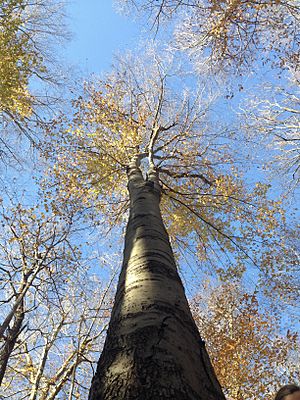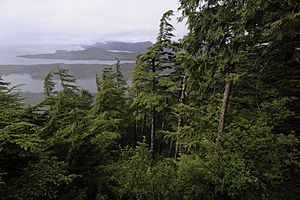Climax community facts for kids

In ecology, a climax community is a group of plants, animals, and fungi that has reached a stable point. This happens after a long process of ecological succession. Succession is how different groups of living things grow and change in an area over time.
Scientists once thought that a climax community was perfectly balanced. They believed it was made of species that fit best with the average conditions of that area. This idea also applied to how soil develops. However, we now know that this "steady state" is not always permanent, especially over very long periods. Still, the idea of a climax community is useful for understanding nature.
The idea of a single climax community, linked to the climate of a region, came from a scientist named Frederic Clements in the early 1900s. Another scientist, Henry Cowles, first wrote about succession leading to a stable point in 1899. But it was Clements who used the word "climax" to describe this ideal final stage of succession.
Early Ideas About Climax Communities
Frederic Clements thought that the way an ecological community develops was similar to how a single organism grows. He compared it to simple organisms. Later, some ecologists took this idea further, suggesting that an ecological community was like a "superorganism." They even tried to find one perfect climax type for each area.
An English botanist named Arthur Tansley added to this idea with "polyclimax." This meant there could be many stable end-points, not just one. These different end-points would depend on things like the soil (called edaphic factors) in a certain climate zone. Clements had other names for these different end-points, but he didn't call them climaxes. He believed they weren't truly stable because, by definition, climax vegetation is the best fit for a given climate.
Another scientist, Henry Gleason, disagreed with Clements' "superorganism" idea early on. His views were mostly ignored for many years. But research in the 1950s and 1960s showed that Gleason was largely right. Despite this, climax theory became very important in both theoretical ecology and how we manage vegetation. Clements' terms, like pre-climax, post-climax, plagioclimax, and disclimax, are still used. They help describe communities that stay in states different from the ideal climax for an area.

Even though some people thought Clements believed climax communities always happened, he didn't. He also didn't think that all species in a community were tightly linked. Instead, he used the idea of a climax community as a starting point. It helped him describe the plants that would grow best in perfect environmental conditions.
Clements spent a lot of time describing what happens when those perfect conditions are not there. In those cases, different kinds of plants will grow instead of the ideal climax. But these different plants can still be described as changes from the ideal climax. So, Clements created many terms to explain why different plants grow and what non-climax states they take on. His way of dealing with how complex nature is was to define an ideal form of plants – the climax community – and then describe other forms as changes from that ideal.
How We Use "Climax" Today
Even though the original climax theory isn't used as much, the idea of "climax" became popular again among some theoretical ecologists in the 1990s. Many writers and nature lovers still use the word "climax" in a simpler way. They use it to mean a mature or old-growth community. The term "climax" has also been used to describe a late stage of development for communities of sea creatures without backbones.
Also, some modern ecologists still use the term "disclimax." This describes an ecosystem that is taken over by invasive species. These invaders stop native species from returning and growing. This idea comes from Clements' early view that a climax ecosystem resists new species moving in. Clements himself used the term "disclimax" in 1936. Even though it's often caused by people, it's one of the few examples of a climax-like state that we can see in nature.
See also
 In Spanish: Climax Community for Kids
In Spanish: Climax Community for Kids
- Stratification (vegetation)

